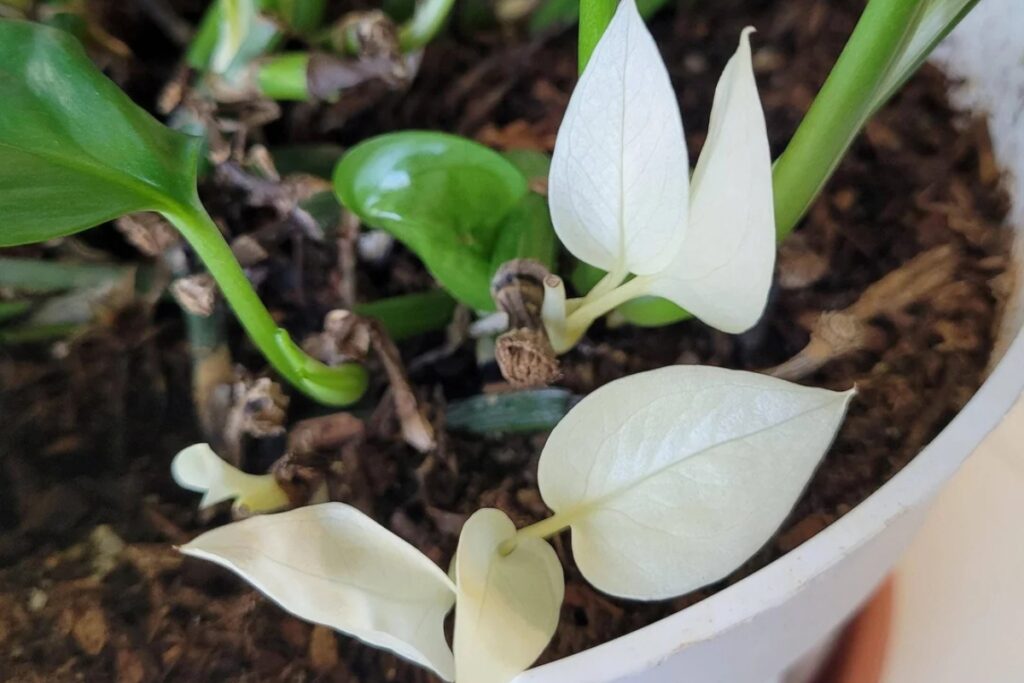Pothos owners often panic when their vibrant green leaves suddenly develop white patches, streaks, or completely pale sections. This dramatic color change can stem from six distinct causes, ranging from completely normal variegation patterns to serious plant health issues requiring immediate intervention. While some white coloration indicates healthy genetic traits, other instances signal problems that could kill the plant within weeks if left untreated.

Contents
Natural Variegation in Pothos Varieties
Nature’s artistry shines brightest in variegated pothos varieties, where white patches and streaks occur naturally as part of the plant’s genetic makeup. Popular cultivars like ‘Marble Queen’, ‘Golden’, ‘Manjula’, ‘Neon’, and ‘Jessenia’ showcase stunning white markings through their variegated genetics. This leaf pigmentation results from chlorophyll absence in specific areas, creating the distinctive white-and-green patterns gardeners adore.
These natural white sections aren’t cause for concern—they’re actually prized features. However, variegated varieties need brighter indirect light than solid-green pothos since their reduced chlorophyll limits photosynthesis efficiency, making proper lighting essential for healthy growth.
Sun Damage and Light Exposure Issues
While variegated pothos naturally display white markings, sudden whitening across previously green leaves often signals sun damage from excessive light exposure. Direct sunlight can scorch delicate pothos foliage, causing chloroplasts to break down and leaves to appear bleached or pale.
Proper light intensity management involves providing bright, indirect light rather than harsh direct rays. Move sun-damaged plants to shadier locations immediately to prevent further deterioration. Effective leaf care includes removing severely damaged foliage and monitoring new growth for recovery signs. Gradually acclimate pothos to brighter conditions over several weeks to avoid shock.

Fungal Infections and Powdery Mildew
What causes white, powdery patches to suddenly appear on pothos leaves? Powdery mildew, a common fungal infection, thrives in high-humidity environments. This fungal disease creates distinctive white or gray powder coating on leaf surfaces, blocking sunlight and hindering photosynthesis.
Immediate removal of infected leaves prevents spreading to healthy foliage. Reducing humidity levels and improving air circulation around the plant creates unfavorable conditions for mildew growth.
Effective fungal treatments include neem oil or baking soda solutions applied weekly. For mildew prevention, maintain humidity below 60% and guarantee adequate spacing between plants. Moving the pothos to a well-ventilated area considerably reduces future infection risks.
Nutrient Deficiencies and Soil Problems
When pothos leaves develop a pale, whitish appearance accompanied by stunted growth, nutrient deficiencies often lurk beneath the surface. Chlorosis occurs when plants lack essential nutrients like nitrogen, potassium, magnesium, or molybdenum. Poor soil quality compounds these problems, creating a cycle of declining plant health.
Long-term potting in depleted soil strips away crucial nutrients. Compact, hard potting mix restricts root growth, while sandy soil prevents proper absorption. Effective soil amendments include adding compost and perlite to improve structure.
Restoring nutrient balance requires diluted liquid fish and seaweed fertilizer applied monthly. Repotting with fresh, well-draining soil rejuvenates struggling plants.
Overwatering and Root Health Problems
Beyond soil nutrition issues, improper watering practices create an entirely different set of problems that manifest as whitish-yellow, limp leaves. Overwatering creates conditions where stagnant water sits at the bottom of pots, suffocating roots and preventing oxygen absorption. This leads to root rot, a serious condition that can kill plants quickly.
Poor soil drainage compounds these issues considerably. When water can’t escape properly, roots literally drown in soggy conditions. The damaged root system struggles to transport nutrients effectively, causing leaves to lose their vibrant green color and develop that telltale whitish appearance with water blisters.
Temperature Stress and Environmental Factors
While watering issues often grab attention first, temperature fluctuations create equally damaging stress that transforms healthy green pothos leaves into pale, discolored versions of their former selves. These plants thrive within 65-85°F, becoming stressed when exposed to sudden changes.
Cold drafts from windows, air conditioners, or heating vents disrupt cellular processes, causing chlorophyll breakdown and whitening leaves. Hot spots near fireplaces or direct sunlight create similar damage through heat shock.
Environmental stability proves essential for maintaining vibrant foliage. Position pothos away from temperature extremes, ensuring consistent conditions year-round for ideal leaf color and plant health.
